Lithium Batteries
Air Cargo Security | Aviation Security Screening | Aviation Sustainability and the Environment
Cockpit Security | Competition from Foreign Airlines | CrewPASS | Federal Flight Deck Officer Program
Fighting Pilot Fatigue | Occupational Safety | Producing Professional Airline Pilots | Runway Safety
Shoulder-Launched Missile Threat | Unmanned Aircraft | Wildlife Hazards
Lithium Batteries:
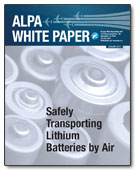 Safely Transporting Lithium Batteries by Air
Safely Transporting Lithium Batteries by Air
Lithium batteries represent a significant technological improvement over older battery types, such as lead acid, alkaline, nickel cadmium, and nickel metal hydride. They are smaller and lighter than previous chemistries, with a higher energy density, have no memory effect, and produce a slow loss of charge when not in use. However, due to their high energy density and flammable electrolyte, these batteries can initiate a fire and burn very violently when shortcircuited or exposed to high temperatures. A short circuit may occur following a manufacturing defect, damage, or by bringing the external battery terminals into contact with other batteries or conducting material. The current provisions for the carriage of these batteries onboard commercial aircraft do not adequately address the risk presented in transport.
Return to top
Air Cargo Security:
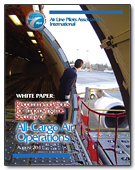 Securing Air Cargo
Securing Air Cargo
ALPA believes that the security of cargo transported on passenger airliners is of critical importance. However, the Association concentrates instead on the most neglected area of cargo security: the measures applicable to all-cargo air operations. Although many improvements have been made in this regard since the events of 9/11, One Level of Security does not yet exist between the passenger and all-cargo domains, while TSA has stated that the threat remains.
See also: Securing Air Cargo Position Paper
Return to top
Aviation Security Screening:
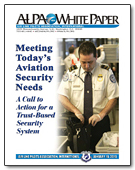 Trust-Based Security System
Trust-Based Security System
Aviation security screening has long focused on the interdiction of threat objects (e.g., guns, knives, improvised explosive devices). The weapons of choice by those who would attack aircraft have evolved over time, and their methods for concealing those weapons continually change. The one constant for all would-be attackers, however, is hostile intent to carry out an assault. ALPA believes that the focus of our security resources should be directed primarily toward identifying those with hostile intent before they are allowed to board our aircraft. Technologies, such as metal detectors, x-ray machines, whole-body imaging machines and the like are valuable tools, but they can never replace the detection of hostile intent
See also: Trust-Based Aviation Security System Position Paper
Return to top
Aviation Sustainability and the Environment:
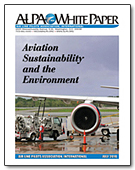 Reducing Aviation’s Impact on the Environment
Reducing Aviation’s Impact on the Environment
Over the past 40 years, the North American airline industry has increased aircraft payload capacity six-fold while concurrently using 60 percent less fuel. Technological improvements in navigation and surveillance have contributed tremendously to improved capacity and operational efficiency in the National Airspace System (NAS), leading to growth in operations without a corresponding increase in aviation’s carbon “footprint.” ALPA strongly supports reducing aviation’s small overall percentage of adverse impact on the environment, partly by advocating for the implementation of the Next Generation Air Transportation System (NextGen).
Return to top
Cockpit Security:
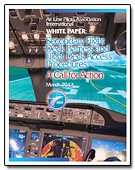 Secondary Flight Deck Barriers And Flight Deck Access Procedures
Secondary Flight Deck Barriers And Flight Deck Access Procedures
Simply put, an open cockpit door provides an attacker the opportunity to invade, and flight crews open the door for flights of any significant duration for a variety of reasons—crewmember coordination and meal service, just to name a few. Installing secondary barriers would enhance a layered system of cockpit defense, effectively delaying, deterring, or entirely preventing attackers’ efforts to gain control of an airliner. ALPA, in concert with industry partners, has long supported adding secondary barriers to passenger and cargo airliners; accompanied by specific flight deck access procedures, it is an ideal security complement to the fortified cockpit door.
See also: Secondary Barriers Position Paper
Return to top
Competition from Foreign Airlines:
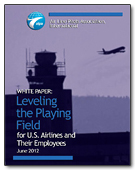 Leveling the Playing Field for U.S. Airlines and Their Employees
Leveling the Playing Field for U.S. Airlines and Their Employees
This paper explores and offers policy solutions to create a better business environment for U.S. airlines and level the playing field in the international marketplace. Issues explored as ways to level the playing field for U.S. airlines and their employees include:
• the problem of excessive oil speculation;
• the low barriers to entry for new carriers, which can lead to undercapitalized and ill-prepared airlines that distort pricing before going out of business;
• the customer experience at the airport;
• the positive impact of tourism on U.S. airlines;
• and investment in NextGen.
Return to top
CrewPASS:
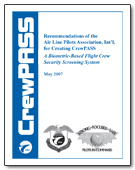 Improving Security Checkpoints
Improving Security Checkpoints
More than seven years after 9/11, the Transportation Security Administration’s screening methodology for pilots is still inefficient. In fact, the TSA screens highly vetted and prescreened pilots more than 40,000 times per day. To address this issue, ALPA proposed the creation of the Crew Personnel Advanced Screening System (CrewPASS), a biometric-based security system that would quickly and accurately verify the identity and employment status of active pilots. Installing CrewPASS at every airport would save the TSA time, money, and resources; improve aviation security; and benefit both pilots and passengers.
See also: Enhanced Crewmember Security Screening position paper
CrewPASS Biometric Enrollment Video
Return to top
Federal Flight Deck Officer Program:
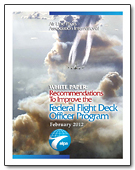 Improving the Federal Flight Deck Officer Program
Improving the Federal Flight Deck Officer Program
When dealing with terrorism, the deterrent value of an armed presence within the cockpit cannot be overstated. Today, thousands of FFDOs protect the flight decks of our nation’s airliners and defend more than 100,000 flight segments per month. In spite of the program’s tremendous value, the TSA has relegated it to a “caretaker” status. While TSA has supported the increase in FFDO ranks, it has not increased the funds necessary for logistical support and infrastructure. ALPA will remain focused on these issues in 2009.
See also: Federal Flight Deck Officer Program Position Paper
Return to top
Fighting Pilot Fatigue:
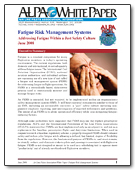 Fatigue Risk Management Systems
Fatigue Risk Management Systems
Sixteen-hour domestic duty days – even longer with some long-range international operations – are facts of life for many airline pilots. Irregular shifts, crossing time zones, all-night operations, and significant circadian rhythm challenges all contribute to the serious safety issue of pilot fatigue. ALPA calls for updating airline flight/duty/rest practices based upon scientifically demonstrated human performance limitations, rather than on economic misperceptions.
See also: Pilot Fatigue Position Paper
ALPA’s “Fighting Fatigue” site
ALPA’s Flight Time, Duty Time Policy
The Airline Pilots’ Guide to Fighting Fatigue
Return to top
Occupational Safety:
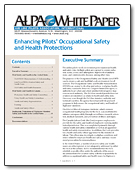 Enhancing Pilots’ Occupational Safety and Health Protections
Enhancing Pilots’ Occupational Safety and Health Protections
The airliner cabin is quite comfortable and accommodating for passengers who may fly only a few trips per year and poses very little risk for them because of the short time spent in that environment. For crewmembers, however, it is quite different. Flight deck crews may spend up to 1,000 hours in flight during any calendar year. During that time they are exposed to a number of environmental hazards. The airline pilot’s work environment poses numerous health and safety risks. In flight, pilots are exposed to cosmic radiation, ozone, a very arid atmosphere, high levels of ambient noise, and communicable diseases, among other risks.
Return to top
Producing Professional Airline Pilots:
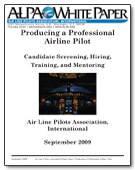 Producing a Professional Airline Pilot
Producing a Professional Airline Pilot
The best and most important safety feature on any airplane is a well-trained, highly motivated and professional pilot. Today’s archaic regulations, however, allow airlines to hire low-experience pilots into the right seat of high-speed, complex, swept-wing jet aircraft in what amounts to on-the-job training with paying passengers on board. That’s why ALPA calls for a complete overhaul of pilot selection and training methods as well as increase mentoring of pilots by their more experienced colleagues.
See also: Pilot Training and Professionalism Position Paper
Return to top
Runway Safety:
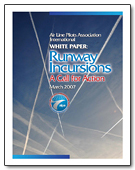 Runway Incursions
Runway Incursions
Increased amounts of air traffic, especially at the highest-volume U.S. and Canadian airports, makes runway safety today more important than ever. ALPA puts pressure on airports and regulators to improve runway design, signage, and technologies. The Association also encourages the airlines to improve training and operational procedures that will help pilots avoid errors on the ground. After all, nothing can replace the awareness of a pilot in the cockpit. ALPA’s Hold Short for Runway Safety web site provides pilots with commonsense guidance that will help prevent operational breakdowns and houses much of ALPA’s runway safety educational materials.
Return to top
Shoulder-Launched Missile Threat:
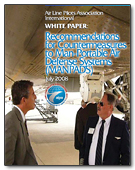 Recommendations for Countermeasures to Man-Portable Air Defense Systems (MANPADS)
Recommendations for Countermeasures to Man-Portable Air Defense Systems (MANPADS)
Security experts are concerned about the threat to commercial airliners by shoulder-fired antiaircraft missiles, also known as MANPADS, or Man-Portable Air Defense Systems. Small, light, and obtainable in the international arms markets, there are thousands of MANPADS in various versions available from surplus or stolen military stocks. Some military aircraft are equipped with special defensive systems that often (but not always) mislead the missile away from its target. Some are now advocating that similar systems be installed on commercial airliners.
Return to top
Unmanned Aircraft:
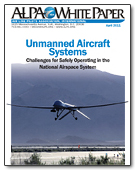 Safely Introducing Unmanned Aircraft
Safely Introducing Unmanned Aircraft
The much-publicized success of Unmanned Aircraft Systems (UAS) in combat operations has created a potentially large commercial market for these aircraft. As the potential for business use increases, so does pressure to allow unrestricted UAS operations in the National Airspace System. ALPA vows to protect the safety and integrity of the NAS and ensure the introduction of UAS operations will not compromise the safety of our members, passengers, cargo or the public at large.
See also: Unmanned Aircraft Systems (UAS) Position Paper
Return to top
Wildlife Hazards:
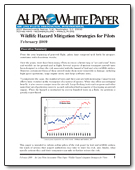 Wildlife Hazard Mitigation Strategies for Pilots
Wildlife Hazard Mitigation Strategies for Pilots
The potential for bird strikes is a risk that is far from new—in fact, the Wright brothers recorded the first bird strike in 1905. Striking large birds at high speeds may result in catastrophic damage to an aircraft engine or an airframe, however, and that’s why ALPA makes sure the industry awareness of this issue remains high. If a 4-pound bird struck an aircraft traveling 250 knots, it delivers the force of approximately 38,000 pounds at the point of impact. ALPA’s safety efforts focus on reducing the possibility of a wildlife strike and the severity of the consequences.
See also: Wildlife Hazards Position Paper
Return to top